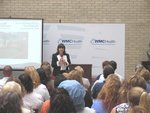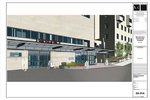 Narrowsburg
NarrowsburgLight Rain Fog/Mist, 43°
Wind: 8.1 mph
 Narrowsburg
NarrowsburgOur healthcare system is a marvelous and perplexing thing, capable of producing both miracles and tragedies, joys and frustrations. As our population grows and our medical capabilities expand, …
Stay informed about your community and support local independent journalism.
Subscribe to The River Reporter today. click here
This item is available in full to subscribers.
Please log in to continue |




Our healthcare system is a marvelous and perplexing thing, capable of producing both miracles and tragedies, joys and frustrations. As our population grows and our medical capabilities expand, healthcare providers are faced with increasingly complex challenges. Among these is the question of efficiency: what is the best way to distribute and allocate finite resources? Such concerns, though, must always be balanced by the personal and interpersonal aspects of health care delivery. Is it best to bring everything together, into massive centralized institutions that can realize “economies of scale” but that can seem cold and impersonal? Or is it better to bring care closer to the consumer, in ways that might be more convenient and accessible but less efficient? Or is there an optimum way to combine the two approaches?
The answers are critical, especially for rural areas like the Upper Delaware. Many small hospitals have closed nationwide, or are at risk of closing. At a recent gathering in Pennsylvania, the state’s Deputy Secretary for Health Innovation reported that “670 rural hospitals in the nation—34% of the total—are at risk for closure.”
A look at two local healthcare systems, not too far from each other on either side of the Delaware River, can help us to examine both approaches. When it comes to centralization, each has announced plans to spend more than $40 million dollars to expand and improve their existing central facilities. Bon Secours Community Hospital is developing a new “medical village” of outpatient services at its home base in Port Jervis, NY, aimed at enabling patients to receive comprehensive care at one location. A “medical village” is a new spin on the traditional medical office building, with a large central family medicine practice surrounded by selected specialists that agree to offer one-of-a-kind patient access and share improved processes, outcomes and data for quality-based and accountable patient care. Meanwhile, Wayne Memorial Hospital (WMH) in Honesdale, PA, has begun a construction project that will expand its current Honesdale building with a new 85,000-square-foot tower housing 50 private patient rooms, and upgrades to its emergency department, laboratory services, chemotherapy and wound-care units. The new tower is set to open in spring of 2019.
The aim of the Bon Secours medical village is to upgrade basic local services and highlight at least one popular specialty program. Thus, the emergency room is being renovated, expanded to 10,000 square feet, and provided with new and more sophisticated diagnostic equipment and laboratory services. Thirty-six semi-private rooms will be converted to private rooms, which may decrease the number of hospital beds but increase comfort and privacy. The nationally accredited weight-loss/bariatric surgery clinic will also be renovated and expanded. Most importantly, Bon Secours will open a new, 47,000-square-foot outpatient center with the participation of community partners: the Orange County Mental Health Department and Cornerstone Community Health Center. It will include primary and specialty services, community health education and a pharmacy. The goal is to raise Bon Secours’ profile as an attractive and convenient local health resource, a “center of excellence” providing “one-stop shopping.”
While Wayne Memorial Hospital (WMH) does not call itself a medical village, it provides a wide array of services at its primary Honesdale location, and the bulk of its outpatient services are provided at the hospital. It also provides an emergency room, 98 acute-care beds, 14 rehab beds, obstetrics, invasive cardiology (but not cardiac surgery), a certified primary stroke center, a Level IV Trauma Center, and many other services. At present, all adult primary care physicians but one in Honesdale are salaried by Wayne Memorial Hospital or its affiliate, Wayne Memorial Community Health Centers.
Though both systems are expanding their primary hospital location and centralized services, in a rural area where population centers are distant and transportation can be a concern, particularly in the winter, some degree of decentralized service delivery is also necessary.
Both WMH and Bon Secours are small medical centers located in small cities surrounded by rural and semi-rural areas. To some extent, Wayne Memorial faces more of a challenge in terms of patient outreach because it is more isolated than Bon Secours. It is surrounded by a large area of medically underserved countryside; the nearest large cities or other medical centers are nearly an hour or more away, in Scranton and Wilkes-Barre. One example of a creative way in which WMHS has met this challenge is its mobile mammography unit, making an essential testing service available over a broad geographical area. In addition, it has one perk that helps to offset any downsides to its isolation: its location has allowed it to be designated a “Sole Community Hospital,” a federal government designation that provides for enhanced reimbursements and protections for Medicare patient care. Between clever outreach ideas and federal help, it manages to extend its services over four Pennsylvania counties.
In addition, both Bon Secours and WMH also have affiliated Federally Qualified Health Centers (FQHC), networks of physician/provider services that can refer patients to the hospitals for services they cannot provide themselves. FQHCs were set up to offer affordable and accessible primary-care services to the underserved, the most vulnerable Americans—the under- and uninsured—in rural and inner-city areas. In return, FQHCs receive many enhancements, such as increased reimbursements and government funding for malpractice insurance for providers. WMHS has Wayne Memorial Community Health Centers (WMCHC), and Bon Secours is affiliated with Cornerstone Family Healthcare, both of which have many locations spread across wide geographical areas. At these locations, patients may receive, for example, primary care, dental care, behavioral health services, women’s health services and pediatric care.
In contrast to WMHS, Bon Secours, though adjacent to rural areas, is also fairly close to the populous New York City suburbs of Westchester County and to several other medical centers, notably Westchester County Medical Center in Valhalla, NY and Orange Medical Center in Middletown. This proximity represents both opportunity and competition for Bon Secours, originally a small Catholic hospital. In denser population areas with better transportation infrastructure, more centralization may make more sense, allow an organization to be more competitive, and be easier to achieve. The hospital is still small (122 acute-care beds, 42 nursing-home beds) and it does not have a maternity unit, but is bolstered by its membership in the Bon Secours Charity Health System, a group of three acute-care hospitals and three long-term care facilities. Even more important is the recent (2015) corporate takeover of the Bon Secours system itself by the much larger Westchester County Medical Center Health Network (WMC Health).
In the context of the WMC system, Bon Secours will be one of two medical villages, the other an expansion of the HealthAlliance center in Kingston. Both medical villages have received major grants from the New York State Health Department’s Delivery System Reform Incentive Payment Program (DSRIP). Bon Secours’ grant provides $24.5 million of the $40 million going into the village.
The role of government—its reforms, overhauls and investments—is a factor very much shared by Wayne Memorial and Bon Secours. Massive amounts of political rhetoric have been generated about government “interference” in healthcare—remember “death panels”? But it’s worth pointing out that without government-mandated needs assessments and government grants, many of our local services would not exist. The Federally Qualified Health Center program was designed to ensure the delivery of healthcare to underserved (rural and inner-city) areas, and both Bon Secours and Wayne Memorial depend upon it in providing services. The DSRIP funds underpinning Bon Secours’ medical village were generated by New York State’s overhaul of Medicaid, which saved money by discouraging unnecessary inpatient hospital care and supporting improved outpatient services. Wayne Memorial is also accessing government aid to complete its $35-million dollar patient tower.Another $5 million is going toward renovation and expansion projects within the current hospital. The overall financing comes partly from investments and municipal-backed bonds.
WMHS is also in line to receive funding from the state of Pennsylvania’s Redevelopment Assistance Capital Program (RACP). It is considering joining the Pennsylvania Department of Health’s new Pennsylvania Rural Health Model program, under which the hospital would begin to give up fee-for-service reimbursement from Medicare, Medicaid and private insurance in exchange for a fixed monthly payment of 1/12 of its annual operating budget.
But whatever payment structures are devised, it’s clear that without Medicare and Medicaid reimbursement neither of these systems could survive. So the key word for the future of healthcare in the Upper Delaware may be neither “centralization” nor “decentralization,” but rather “integration”—integration of multiple models, locations, and funding sources.
[JF Shaw is a retired physician living in Tyler Hill, PA.]
Comments
No comments on this item Please log in to comment by clicking here